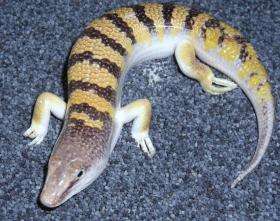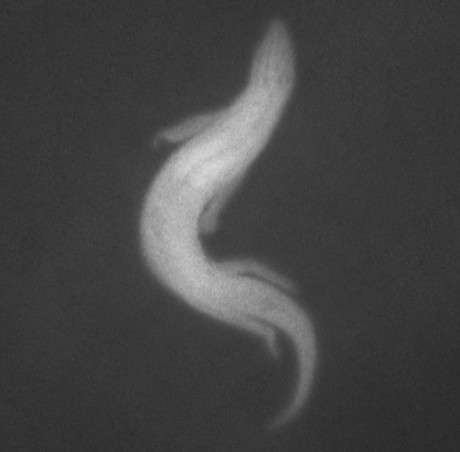February 25, 2011 report
Why the sandfish lizard wriggles as it does (w/ Video)

(PhysOrg.com) -- The sandfish lizard (Scincus scincus) lives in the desert sands of North Africa and burrows through the sand by wriggling. Now scientists in the US have created a computer model that emulates the physics of the lizard and other burrowing animals.
Professor Daniel Goldman of the Complex Rheology And Biomechanics Laboratory (CRAB Lab) at the Georgia Institute of Technology in Atlanta, said it is not easy to study the movements of burrowing animals because sand grains bounce off each other wildly rather than creating the kind of flowing movements found when animals move through water or air.
Previous studies using X-rays revealed that the sandfish lizard moves through the sand by wriggling in S-shaped curves with their legs tucked in. Dr. Goldman said the wriggling movements of the lizard enable it to move at great speed, since it can cover two body lengths every second, but it was unclear at that time exactly how they achieve those speeds in sand.
Goldman’s team then built a snake-like robot capable of moving in a similar way to the living lizard, and were able to control the extent of bending and wriggling as the robot moved. They filmed the robot moving through sand to determine how the amount of curling affected their movements.
The team followed with computer simulations of the lizards swimming through a field of beads 3mm in diameter. Even with 3 mm beads rather than tiny grains of sand, the simulations needed the computing power of 20-30 ordinary PCs to run, and still took several days. They used the simulation to analyze the movement of every bead affected by the passing lizard. Both the living lizard and robot swam through the glass beads in the same way as they did through sand.
The simulation and robotic tests both gave the same answer: if the lizards curl too little they cannot provide enough power to push through the sand, while if they curl too much they do not move very far forward as they wriggle. The movements of the living lizard are close to optimum.

Dr Goldman also said the studies suggest that sandfish lizards dive into the sand and wriggle down into it to escape from predators as fast as possible. Burrowing into the sand also enables them to escape the scorching heat of the desert.
As a result of their experiments Goldman’s team were able to derive a mathematical theory and highly predictive computer model capable of emulating the physics of sand and objects or animals moving through it. Dr Goldman said the model is the first really detailed, quantitative and accurate model of objects moving through an environment other than air or water.
The research could find applications in a number of fields involving objects beneath the surface, such as earthquake monitoring and landmine detection. It could also lead to robots designed to wriggle into the sub-surface on other planets, and the team is already talking to NASA representatives about the possibilities.
More information: Mechanical models of sandfish locomotion reveal principles of high performance subsurface sand-swimming, Ryan D. Maladen, Yang Ding, Paul B. Umbanhowar, Adam Kamor, and Daniel I. Goldman, Journal of the Royal Society Interface, in press (2011).
© 2010 PhysOrg.com


















